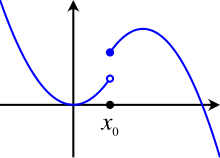In mathematics one is real-valued function upper continuous (or semi-continuous from above ) at a point when the function values for arguments near by starting not jump up. If the function values do not jump down, then the function is called lower continuous in (or semi-continuous from below ).





definition

Above semi-continuous function (the fully filled blue point indicates )

Let be a topological space , in and a real-valued function. is called in above-semi-continuous if there is a neighborhood of for each such that in holds for all . If a space in which every sequential function is also continuous, say a metric space, then is above semi-continuous in if and only if















-
 .
.
 is called semi-continuous on a subset of if it is above semi-continuous at every point . If the whole topological space is here , then it is called above-semi-continuous.
is called semi-continuous on a subset of if it is above semi-continuous at every point . If the whole topological space is here , then it is called above-semi-continuous.







Sub-continuous function (the fully filled blue point indicates )

In the point , analog means sub- continuous if there is a neighborhood of for each , so that for all in . If a space in which every sequential function is also continuous, say a metric space, then is subcontinuous in if and only if











-
 .
.
 is called sub-continuous on a subset of if it is sub-semi-continuous at every point . If the entire topological space is included , then it is called sub-continuous.
is called sub-continuous on a subset of if it is sub-semi-continuous at every point . If the entire topological space is included , then it is called sub-continuous.






Relationship between the two terms of semi-continuity: The function is above- semi-continuous in or on when below- semi-continuous in or on .






Examples
The function with for and for is above-semi-continuous, but not below-semi-continuous in . Because if you move away from 0 with the arguments in a negative direction, then the function values suddenly jump from 1 to 0, but they don't jump up, regardless of where you move away.






The Gaussian bracket is above- half continuous because it behaves like the function just described for every whole number .

properties
A function is continuous in if and only if it is semi-continuous from above and from below. This follows from a reformulation of the continuity condition, which is that, for every one is such that for all from the environment of the inequality holds. This is equivalent to . Here the left inequality sign means the lower semicontinuity and the right inequality sign means the upper semicontinuity.









If and are two in above-half continuous functions, then their sum is also in above-half continuous. If both are not negative in an environment of , then the product is in upper semi-continuous. The multiplication of a positive over-half continuous function by a negative real number results in a under-half continuous function.








If a compact set (for example a closed interval with real numbers ) and above semi-continuous, then has a maximum . The same applies to a sub-continuous function and its minimum.

![[a, b]](https://wikimedia.org/api/rest_v1/media/math/render/svg/9c4b788fc5c637e26ee98b45f89a5c08c85f7935)




Are the functions (for everyone ) sub-continuous and their supremum


less than for any in , then is sub-continuous. Even if all are continuous, it doesn't have to be continuous.






Alternative description
By a suitable choice of a topology to be construed to above continuous and semi-continuous functions as continuous functions, and thus some of the properties can be derived directly from general statements from the topology.

![O _ {{<}}: = {\ Big \ {} \ left] - \ infty, a \ right [; a \ in \ mathbb {R} \ cup \ {+ \ infty \} {\ Big \}} \ cup \ {\ varnothing \}](https://wikimedia.org/api/rest_v1/media/math/render/svg/5a29c0ea170ba9217eb27d26f13bf463a1625558) is a topology on . Be a topological space. A function is above semi- continuous if and only if is continuous as a mapping .
is a topology on . Be a topological space. A function is above semi- continuous if and only if is continuous as a mapping .





The topology is used analogously for sub-continuous functions .
![O _ {{>}}: = {\ Big \ {} \ left] a, \ infty \ right [; a \ in \ mathbb {R} \ cup \ {- \ infty \} {\ Big \}} \ cup \ {\ varnothing \}](https://wikimedia.org/api/rest_v1/media/math/render/svg/c0cce2cdefe1856be02c303e08fe845d1bcd1196)
Weak semi-continuous functions
A generalization of the semi-continuous functions are the weakly semi-continuous functions. Let be a normalized space and a subset. A function or a functional is called



-
weakly sub-semi-continuous on the set , if for each sequence in that weakly converges towards its weak limit, then




-
 .
.
-
weakly above-semi-continuous on the set , if for every sequence in that weakly converges towards its weak limit , it holds that




-
 .
.
For example, continuous quasi-convex functions are weakly sub-semi- continuous . The equivalent of a function's weak sub-continuity is that its epigraph is a weakly sequence-closed set . Weakly sub-continuous functions play an important role in the optimization, since they always assume a minimum on weakly sequential-compact sets .
literature
- Carl Geiger, Christian Kanzow: Theory and numerics of restricted optimization tasks . Springer-Verlag, Berlin Heidelberg New York 2002, ISBN 3-540-42790-2 .

































![[a, b]](https://wikimedia.org/api/rest_v1/media/math/render/svg/9c4b788fc5c637e26ee98b45f89a5c08c85f7935)








![O _ {{<}}: = {\ Big \ {} \ left] - \ infty, a \ right [; a \ in \ mathbb {R} \ cup \ {+ \ infty \} {\ Big \}} \ cup \ {\ varnothing \}](https://wikimedia.org/api/rest_v1/media/math/render/svg/5a29c0ea170ba9217eb27d26f13bf463a1625558)


![O _ {{>}}: = {\ Big \ {} \ left] a, \ infty \ right [; a \ in \ mathbb {R} \ cup \ {- \ infty \} {\ Big \}} \ cup \ {\ varnothing \}](https://wikimedia.org/api/rest_v1/media/math/render/svg/c0cce2cdefe1856be02c303e08fe845d1bcd1196)






